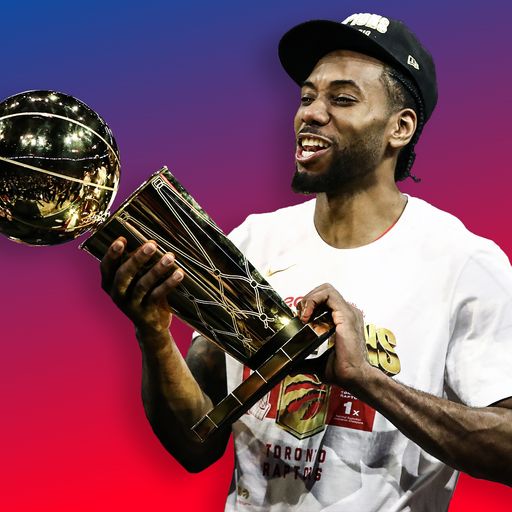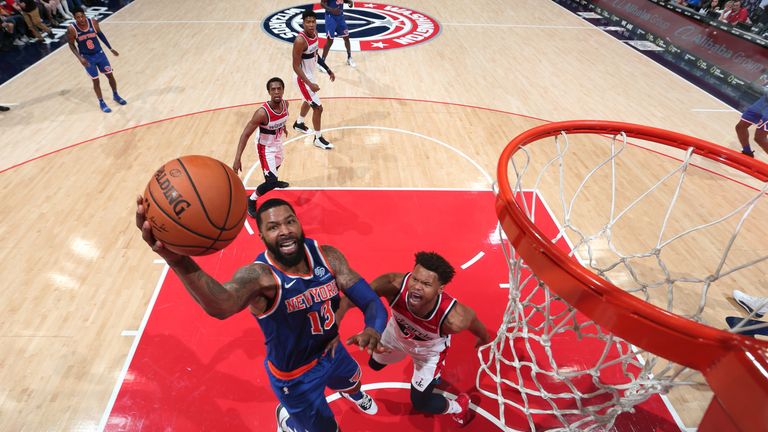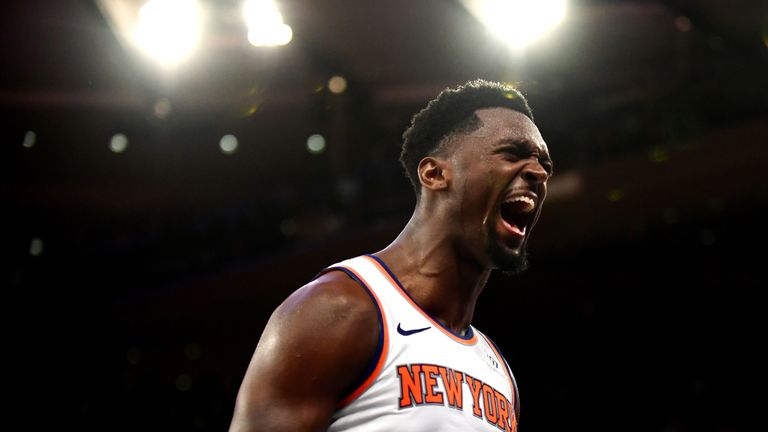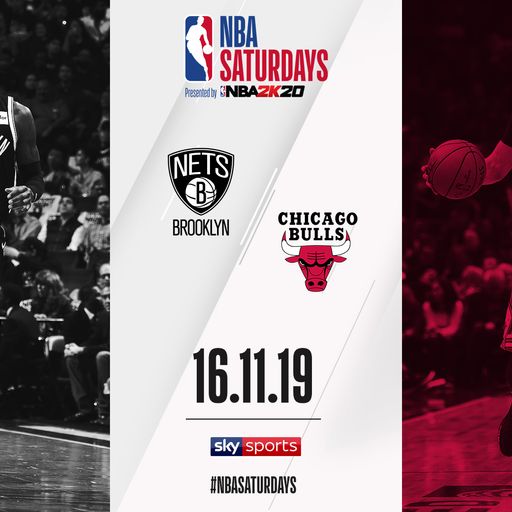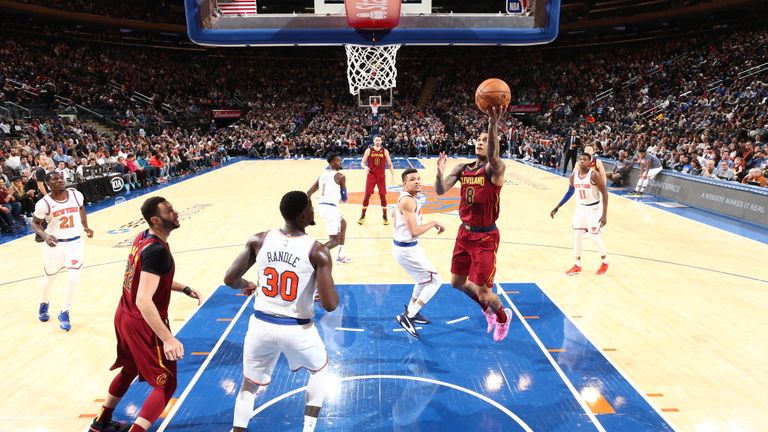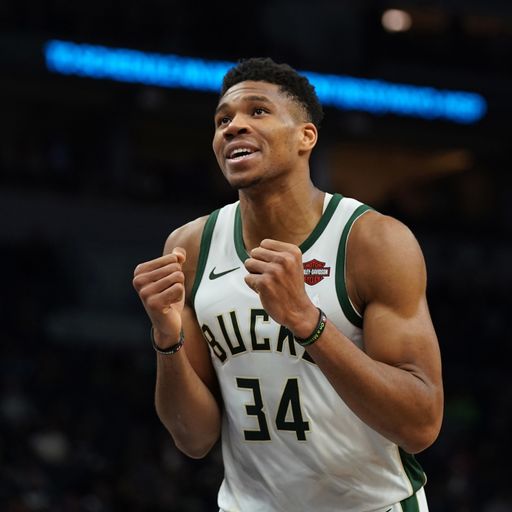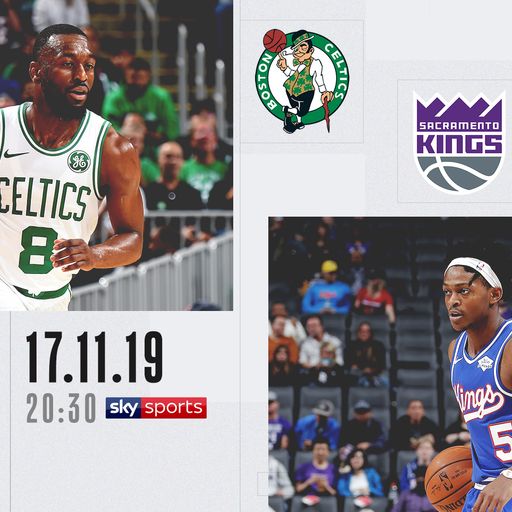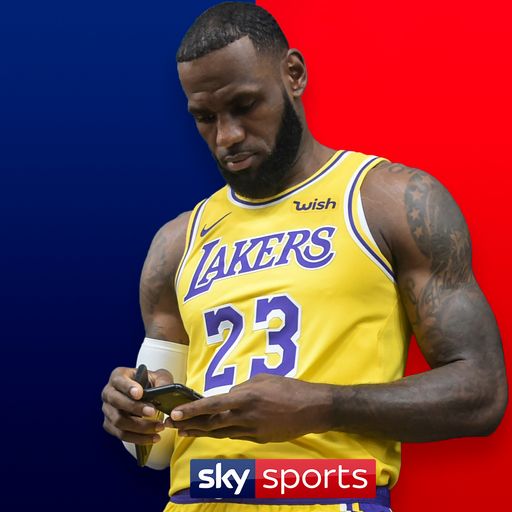RJ Barrett makes strong start in spite of incompatible Knicks roster around him
Watch Dallas Mavericks @ New York Knicks live on Sky Sports Arena in the early hours of Friday morning (1am)
Friday 15 November 2019 06:29, UK
Being paired with what should be incompatible veteran colleagues has not stopped New York Knicks rookie RJ Barrett from making an impressive start to the season, writes Sky Sports NBA analyst Mark Deeks.
As the early stages of the 2019 free agency scramble played out across Twitter, big name after big name came and went, and none of them went to the New York Knicks.
Targets such as Kyrie Irving (who went to Brooklyn), Kevin Durant (who went with him), Klay Thompson (who re-signed with the Golden State Warriors) and Kawhi Leonard (who ruled the Knicks out early, ultimately joining the LA Clippers) opted not to play in the Big Apple, and trading away Kristaps Porzingis for draft picks and salary relief to be in the free agency shuffle had washed out with a whimper.
In view of having star players to spend the money on, the Knicks instead opted for a plethora of role players. Julius Randle and the comparable Bobby Portis joined up front, and, after a brief squabble with the San Antonio Spurs, so did Marcus Morris. Veteran defensive big man Taj Gibson joined with point guard Elfrid Payton. And with shooters Wayne Ellington and Reggie Bullock getting short-term deals of their own, the money was all spent.
For no stars.
Trending
- Man City latest - Pep: City chair supports me 'incredibly'
- Transfer Centre LIVE! Bayern want Dortmund's English winger Gittens
- PL Predictions: Forest to turn up heat on stubborn Ange
- Littler targets nine-dart history: 'It's becoming a frustration'
- Liverpool latest: Slot says it's 'so hard' to win a league
- Tarkowski: Everton are confident of getting result at Man City
- Amorim: Man Utd are maybe in one of their lowest moments
- Man Utd latest: Dalot spends Christmas Eve helping homeless
- World Darts Championship schedule: Who is playing when after Christmas?
- Kelce breaks record as Chiefs beat Steelers to clinch No 1 seed
No one doubts that those seven are all NBA players, and none of the price tags are too egregious either. As far as scrambling to find a Plan B goes, they did relatively well from a financial point of view.
However, the value of each individual piece of the puzzle is not as important as their overall place within the identifiable core of the team. And although none of the individuals are bad eggs, their contractual situations and on-court duplication may not create the best environment for the team's few young players with promise.
The most obvious duplication comes in the frontcourt, where all of Randle, Gibson, Portis, Morris and second-year lottery pick Kevin Knox arguably all play better at the power forward position. Given the age-related decline in Gibson's game, none of them are rim protectors - the only one on the team is hugely promising sophomore Mitchell Robinson, but due to his own extremely high foul rates, inexperience, skill-set limitations and the need to preserve his dominant athleticism, he plays less than half the game. This means that the Knicks go more than half of every night without some back-line defense.
In the backcourt, Payton has not been healthy, and even if he had, he is not a half-court offensive hub; despite a willingness to pass the ball, Payton is not an incisive creator in pick-and roll-situations. His backup Frank Ntilikina continues to be a defense-only player, still only occasionally showing flashes of offensive competence in his third season, while Dennis Smith was absent for the first 10 games of the season owing to the death of a family member.
The team's guard rotation is among the weakest in the league, if not the outright weakest.
Further to the lack of frontcourt defense and backcourt creation is a conglomerate of wannabe scorers whose styles may not blend very well. Randle, in particular, is a tough one to accommodate; his growth over the last couple of seasons as an offensive player has been striking, but he does so in a very isolation-heavy way that sees him handle the ball a lot up top, often carelessly. He is best when attacking in semi-transition, but when a defense is set, he likes to hold the ball before attacking. This stagnates ball movement, and with Morris (a player who has also hugely improved his output over the past couple of seasons, but who plays with blinkers on) also aggressively casting up shots, the ball tends to stop.
With Portis and Knox also being aggressive offensive players, the Knicks have lacked for creation, unselfishness and efficiency all season despite the strengths of their individual talents. The pass is quicker than the dribble, the cut is more efficient than the drive, and yet this Knicks team is full of players who like to have their own turns while standing around when the ball is not in their hands.
This is not their fault, necessarily - this is how they have been raised to play, and not everyone will be a mover and no-dribble player like Ellington. But putting them all together has made for an offense that so far is ranked last in the NBA in offensive rating, fifth-last in pace, last in field goal percentage, last in free throw percentage, fifth-last in assists and seventh-last in turnovers per game.
The theory behind targeting the veterans that they did - that is, the supposed theory beyond just getting the best available players remaining - was that having veterans established in the NBA would ease some of the burden on the team's youth. Signing them to short contracts with unguaranteed portions was designed to keep them hungry, as well as to keep open cap space aspirations for the future that will hopefully go better than last time.
In theory, the wisdom of Gibson, the talent of Randle, the versatility of Portis and the gumption of Morris would set the tone for the environment that the Knicks want their recent draft picks to grow into. In practice, though, signing all the short-term deals means players wanting to prove themselves, playing for their numbers, knowing they will be back on the market very soon. This does not figure to be a good environment conducive to young player development.
Which makes the early season play of RJ Barrett all the more impressive.
Barrett, drafted third in the 2019 Draft, came into the NBA with lofty billing but lots to prove. In his only season at Duke, he lacked for offensive flow, with spotty decision-making and slow reactions to plays as they unfolded on the fly. Heavily left-hand dominant, he seemed not to know how to play off the ball, seemingly another player raised in his basketball education who never got the reps in this role to become a more complete all-around player.
Considering this is also true of several Knicks players, the composition of the team around him - full of shot-hungry veterans with similar shortcomings in their game, who lack the pace to get easy baskets in transition and whom are not forcing turnovers defensively to more regularly go up against defenses before they get set - could in theory be brutally unfit to pair with the supposed franchise cornerstone.
That, however, has not been the case in the season's first 11 games. Or at least, if it has, Barrett's individual play has been a suitably bright spot to overcome that. On the season so far, he averages 16.0 points, 5.8 rebounds, 4.1 assists and 1.4 steals, recording a team-high 35.0 minutes per game.
The scoring has not been efficient. Barrett has only a .462 true shooting percentage thus far, only 12 points above the famously net offensive negative that is Ntilikina. This is however in part due to anomalously poor free-throw shooting which will revert to the mean over time.
On the court, Barrett is already shouldering a significant portion of the playmaking burden, with his 23.9 per cent usage rate ranking second on the team behind only Randle.
Barrett's usage that far has seen him spend 63 per cent of his time in either isolation. spot-up, post-up or transition possessions.
He ranks only in the 10th percentile in the top two thus far, but the roster construction around him is likely a significant factor. Around a player who gets to the rim in isolation, hits some jump shots and takes smaller opponents into the post, you would ideally like to have plenty of floor-spreading options, players willing to cut to open spots and score maximum points with minimal dribbles.
Aside from the lob threat of Robinson and - when his jumper returns - the spacing of Ellington, the Knicks do not really have them. As a result, Barrett has been driving against plugged lanes and not exactly getting open looks with the jumper.
Nonetheless, Barrett is showing good signs as an individual. He is demonstrating both passing vision and willingness on the move, and has a smooth handle in traffic, assuaging somewhat the concerns about the weakness in his right hand.
He needs to improve his shooting from all areas, but so do all players his age, and even if he is not making a great deal of the resultant attempts, he is demonstrating that he can get to his favourite spots on the floor with the ball in his hands, a key skill for an offensive star, as New York are hoping he will be.
Barrett is also putting in some decent turns as a defensive player, a similarly important part of his development that was also a concern coming out of college. If he keeps up that motor, the results will come.
Four Knicks players average as-near-as-is 20 shots per 100 possessions. Barrett, however, is the one with the promise and, it would appear, the greater desire to move the ball.
The fear with his projection was that he would play like a ball hog with no court awareness, forcing his way to the basket and clunking up necessarily difficult attempts, combined with inefficient outside shooting, limited dexterity in his handle and a lack of defensive motor.
Perhaps being paired with what should be incompatible veteran colleagues with similar flaws has, in fact, helped him embrace all the things he was not previously doing.



